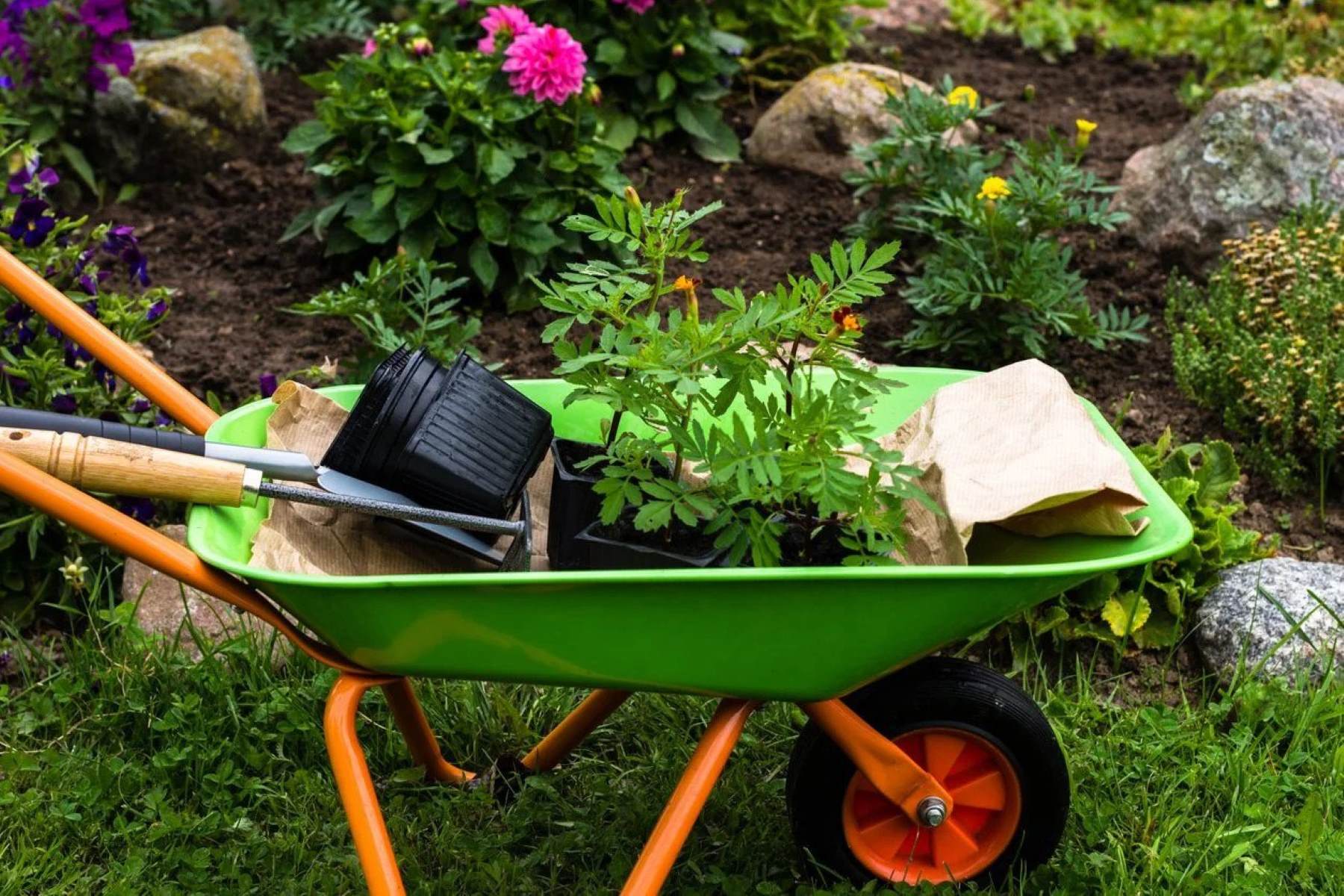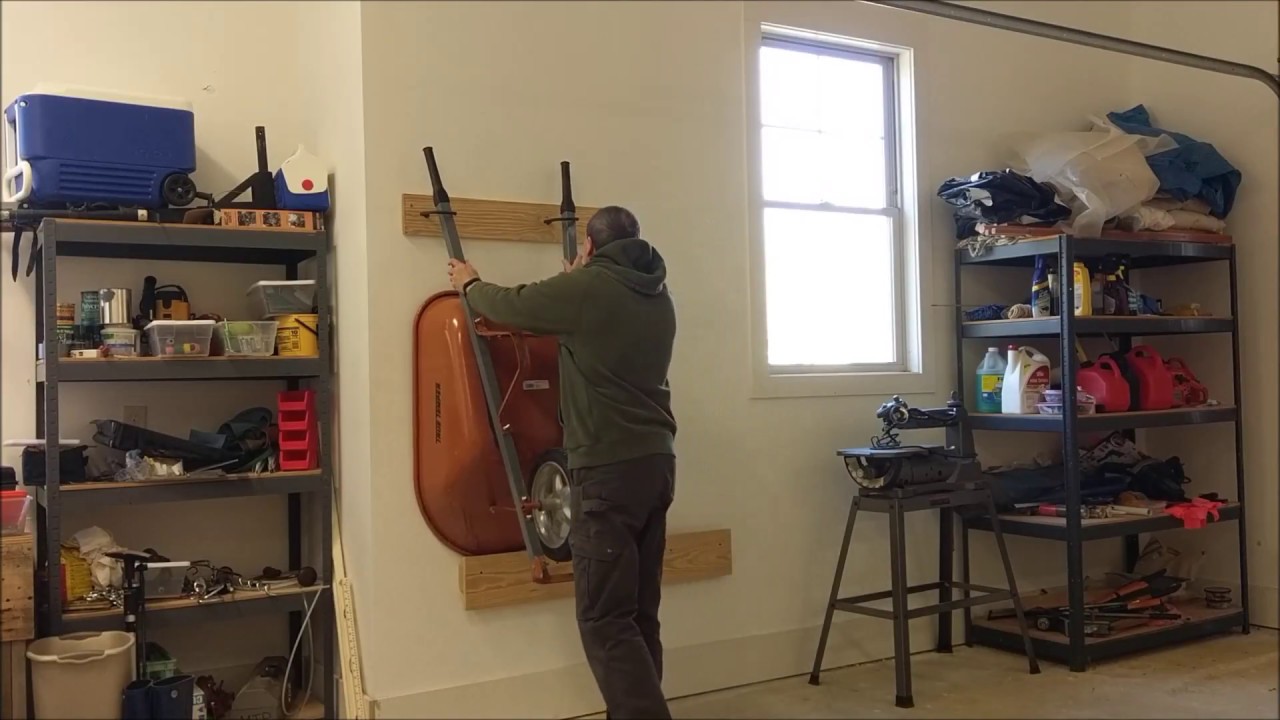

Articles
How To Store Wheelbarrow
Modified: December 7, 2023
Discover the best articles on how to store a wheelbarrow and keep it in great shape. Learn valuable tips and tricks from experts to maximize its lifespan.
(Many of the links in this article redirect to a specific reviewed product. Your purchase of these products through affiliate links helps to generate commission for Storables.com, at no extra cost. Learn more)
Introduction
Welcome to this comprehensive guide on how to store a wheelbarrow. Whether you use your wheelbarrow for gardening, construction, or other heavy-duty tasks, proper storage is essential to keep it in good condition and prolong its lifespan. By following a few simple steps, you can ensure that your wheelbarrow remains functional and ready for use whenever you need it.
A wheelbarrow is a versatile tool that helps you transport heavy loads with ease. However, when not in use, it is important to store it properly to prevent damage from weather conditions, rust, and other factors that can affect its durability and performance.
In this article, we will take you through the step-by-step process of storing your wheelbarrow correctly. From choosing a suitable location to regular maintenance and inspections, we will cover everything you need to know to keep your wheelbarrow in optimal condition.
So, let’s dive in and learn how to store your wheelbarrow effectively!
Key Takeaways:
- Properly storing your wheelbarrow is crucial for maintaining its functionality and prolonging its lifespan. From choosing a suitable location to regular maintenance, these steps will ensure your wheelbarrow remains in excellent condition for years to come.
- By following the step-by-step guide for wheelbarrow storage, you can protect it from damage caused by improper conditions. Choosing a suitable location, cleaning, and regular maintenance are key to ensuring your wheelbarrow remains in optimal condition.
Read more: How To Store A Wheelbarrow
Step 1: Choose a Suitable Location
The first step in storing your wheelbarrow is to choose a suitable location. Ideally, you should store it in a dry and covered area, such as a garage, shed, or any other enclosed space. This will protect the wheelbarrow from exposure to rain, snow, and direct sunlight, which can cause damage to the materials and components.
If you don’t have access to an indoor storage space, consider investing in a wheelbarrow cover or tarp to provide extra protection when storing it outdoors. Make sure the chosen location is free from moisture and has proper ventilation to prevent the buildup of condensation, which can lead to rust and corrosion.
When selecting the storage spot, take into consideration the size of your wheelbarrow and ensure there is enough space to store it without it being in the way or at risk of being knocked over. Avoid storing the wheelbarrow in areas with high foot traffic to minimize the chances of accidental damage.
Additionally, it is important to choose a location that is easily accessible. You don’t want to struggle to retrieve the wheelbarrow when you need it for a task. Keep in mind that wheelbarrows can be heavy, so it’s best to store them in a place that allows for easy maneuvering and lifting.
By selecting a suitable location for storage, you are already taking the first step towards prolonging the lifespan of your wheelbarrow and keeping it in great condition for future use.
Step 2: Clean and Prepare the Wheelbarrow
Before storing your wheelbarrow, it’s essential to clean and prepare it properly. This ensures that any dirt, debris, or moisture is removed, preventing the growth of mold or causing damage over time.
Start by emptying the wheelbarrow of any remaining contents, such as soil or debris. Use a garden hose or a bucket of water to rinse out the inside of the wheelbarrow. If there are stubborn stains or dried-on dirt, you can use a scrub brush or sponge with mild soap and water to scrub the surface clean.
Next, pay attention to the tire and wheel assembly. Check for any debris or sharp objects stuck in the tire, as these can cause punctures or damage. Use a brush or your hands to remove any dirt or stones lodged between the treads. Inspect the tire for any signs of wear or damage, such as cracks or tears, and consider replacing it if necessary.
The handles and frame of the wheelbarrow should also be cleaned. Remove any dirt or grime using a damp cloth or sponge. If there are any rust spots, you can lightly sand them with fine-grit sandpaper and apply a rust-resistant spray or paint to prevent further corrosion.
Once the wheelbarrow is clean, allow it to dry completely before moving on to the next step. Moisture trapped in the wheelbarrow can lead to rust and damage, so it’s important to ensure it is thoroughly dried before storing it.
In addition to cleaning, you may also want to consider lubricating any movable parts, such as the wheel axles or the pivot points of the handles. This will help prevent rust and keep the wheelbarrow functioning smoothly when you use it again.
By cleaning and preparing your wheelbarrow before storage, you are maintaining its cleanliness and preventing any potential damage or issues that may arise during the storage period.
Step 3: Remove Loose or Detachable Parts (if applicable)
In this step, we will focus on removing any loose or detachable parts from your wheelbarrow, if applicable. Not all wheelbarrows have removable components, but if yours does, it’s important to take a few extra steps to ensure their proper storage.
Start by identifying any parts of your wheelbarrow that can be detached, such as handles, trays, or even wheels. Carefully remove these components one by one, following the manufacturer’s instructions if available. Take note of how they are attached so that you can easily reassemble them later on.
Once the parts are removed, clean them separately using the same cleaning techniques mentioned in Step 2. This ensures that each component is thoroughly cleaned and prepared for storage. Pay special attention to any hinges, joints, or connection points, as these areas are more susceptible to rust or corrosion.
After cleaning, allow the detached parts to dry completely before storing them. This will prevent any moisture from being trapped and causing damage while in storage. You can place them on a clean, dry surface or hang them on hooks if available, keeping them off the ground and out of the way.
As for the main body of the wheelbarrow, make sure any remaining parts, such as the frame or tray, are secure and in their proper position. This will prevent any unnecessary stress or potential damage to the wheelbarrow while it is stored.
By removing and storing loose or detachable parts separately, you are ensuring that each component remains in good condition and is ready for reassembly when you need to use the wheelbarrow again. This step may require a bit of extra effort, but it can greatly contribute to the overall maintenance and longevity of your wheelbarrow.
Step 4: Position the Wheelbarrow Correctly
Once your wheelbarrow is clean, dry, and any detachable parts have been removed and stored separately, it’s time to position it correctly for storage. Proper positioning not only helps save space but also prevents any unnecessary strain on the wheelbarrow’s structure and tires.
If your wheelbarrow has a single wheel, position it so that the wheel is facing upwards, pointing towards the ceiling. This will prevent any unnecessary pressure on the wheel, reducing the risk of deformation or flat spots developing over time.
If your wheelbarrow has two wheels or a flatbed design, you can position it in an upright position, with the handles touching the ground. The weight of the wheelbarrow should rest on the handles and front legs, providing stability and preventing any strain on the tires or frame.
For wheelbarrows with pneumatic tires, it’s a good idea to slightly deflate the tires before storage. This helps to relieve any pressure on the tires and reduces the risk of cracks or leaks. However, be sure not to deflate them completely, as this could cause the tires to lose their shape.
When positioning the wheelbarrow, try to avoid placing heavy objects on or against it. This can cause unnecessary stress on the structure or even damage it, especially if the objects are sharp or have rough edges.
If you have limited space for storage, consider using wall hooks or hangers designed specifically for wheelbarrows. These allow you to hang the wheelbarrow on the walls, keeping it off the floor and creating more floor space.
By positioning your wheelbarrow correctly for storage, you are ensuring that its structure and tires remain in optimal condition, ready for use whenever you need them.
Store your wheelbarrow in a dry, covered area to protect it from the elements. Hang it on a wall or store it upside down to prevent water from collecting in the tray.
Read more: How To Store Wheelbarrow In Garage
Step 5: Storing the Wheelbarrow
Now that your wheelbarrow is clean, prepared, and positioned correctly, it’s time to store it properly. The way you store your wheelbarrow can have a significant impact on its longevity and overall condition. Here are some tips for storing your wheelbarrow effectively:
1. Stability: Ensure that the wheelbarrow is stable and securely positioned. If necessary, use blocks or supports to prevent it from tipping over or rolling unexpectedly.
2. Avoiding Pressure Points: Avoid resting heavy objects on top of the wheelbarrow, as this can cause unnecessary strain and potential damage to the frame or tray.
3. Space Efficiency: If you have limited storage space, consider stacking lightweight items inside the wheelbarrow to maximize space utilization. Be cautious not to overload it or place items that could cause damage.
4. Secure Loose Parts: If you have detached any parts, make sure to store them safely nearby or in a designated storage area. This ensures easy access for reassembly when needed.
5. Accessibility: Position the wheelbarrow in a location where it is easily accessible. This will help you retrieve it without hassle when you need it for your next project.
6. Wheel Protection: If your wheelbarrow has pneumatic tires, placing a piece of plywood or a thick mat underneath the wheels can help prevent flat spots from forming during long periods of storage.
7. Consider Climate: Depending on your climate, you may need to take additional precautions. For instance, if you live in an area with high humidity or extreme temperatures, you may want to use moisture-absorbing packs or desiccants to protect against moisture damage or corrosion.
Remember, the goal of proper storage is to protect your wheelbarrow from the elements, prevent damage, and ensure it remains in good working order for years to come.
Step 6: Cover and Protect the Wheelbarrow
Once your wheelbarrow is properly positioned and stored, the next step is to cover and protect it. Covering your wheelbarrow provides an extra layer of defense against dust, debris, and the elements, helping to maintain its condition. Here’s what you need to do:
1. Wheelbarrow Cover: Invest in a wheelbarrow cover specifically designed for your model or opt for a universal cover that fits most wheelbarrows. These covers are made from durable materials that shield the wheelbarrow from sunlight, rain, and dust. Ensure that the cover is long enough to reach the ground and securely fastened to prevent it from blowing away in windy conditions.
2. Tarp or Plastic Sheet: If you don’t have a dedicated wheelbarrow cover, you can use a tarp or heavy-duty plastic sheet to protect it. Make sure the tarp or sheet is large enough to completely cover the wheelbarrow and secure it with bungee cords or weights to prevent it from shifting or blowing away.
3. Moisture Protection: To safeguard against excessive moisture, consider placing a moisture-absorbing pack or desiccant inside the wheelbarrow. These packs help to absorb any moisture that might accumulate and minimize the risk of rust or corrosion.
4. Storage Bag for Detachable Parts: If you have removed any detachable components, store them in a separate storage bag or container. This will protect them from dust and ensure they are easily accessible when you need them again.
5. Regular Inspection: It’s important to periodically inspect your covered wheelbarrow to ensure that the cover is secure and in good condition. Check for any signs of moisture buildup or damage, and make necessary adjustments or repairs as needed.
By covering and protecting your wheelbarrow, you are adding an extra layer of defense against the elements and keeping it in optimal condition for future use.
Step 7: Regular Maintenance and Inspections
Even though your wheelbarrow is stored properly, it’s important to perform regular maintenance and inspections to ensure its longevity and functionality. By staying on top of maintenance tasks, you can address any issues before they become major problems. Here are the key maintenance steps to follow:
1. Cleaning: Regularly clean your wheelbarrow, even when it’s in storage. This helps to remove any dust, dirt, or debris that may have accumulated. Use a damp cloth or hose to clean the surface, and dry it thoroughly before storing it again.
2. Lubrication: Apply lubricant to movable parts, such as wheel axles and pivot points, to keep them working smoothly. This helps to prevent rust and corrosion, ensuring that the wheelbarrow remains easy to maneuver.
3. Tire Care: Check the tires regularly for any signs of wear, damage, or low pressure. Inflate the tires to the recommended PSI if necessary, and replace them if they are worn out or punctured. Properly inflated tires ensure smooth operation and prevent unnecessary strain on the wheelbarrow.
4. Rust Prevention: Inspect the wheelbarrow for any signs of rust or corrosion. If you discover any rust spots, use sandpaper to gently remove the rust, and then apply a rust-resistant paint or coating to prevent further corrosion. Regularly inspecting and addressing rust helps to preserve the structural integrity of the wheelbarrow.
5. Loose Fasteners: Check for any loose screws, bolts, or fasteners and tighten them as necessary. Loose parts can compromise the stability and functionality of the wheelbarrow, so it’s important to address them promptly.
6. Handle Grips: If your wheelbarrow has handle grips, regularly inspect them for wear and tear. Replace them if they are worn out or damaged to ensure a secure and comfortable grip during use.
7. Seasonal Preparations: Adjust your maintenance routine based on the seasons. For example, during colder months, you may need to pay extra attention to moisture prevention and tire care to protect your wheelbarrow in harsh weather conditions.
By performing regular maintenance and inspections, you can prolong the life of your wheelbarrow and ensure it remains in excellent working condition for years to come.
Conclusion
Congratulations! You have now learned the essential steps for storing your wheelbarrow effectively. By following these steps, you can prolong the lifespan of your wheelbarrow, maintain its functionality, and protect it from potential damage caused by improper storage conditions.
Remember, choosing a suitable location, cleaning and preparing the wheelbarrow, removing any loose or detachable parts (if applicable), positioning it correctly, covering and protecting it, and conducting regular maintenance and inspections are all crucial steps in the storage process.
A properly stored wheelbarrow will be ready for use when you need it, whether it’s for gardening, construction, or any other heavy-duty tasks. Taking the time to store it correctly will save you from potential frustration and unnecessary expenses in the long run.
Now that you have the knowledge, make sure to implement these steps and create a routine for wheelbarrow storage. Your wheelbarrow will thank you by remaining in excellent condition and serving you well for many years to come.
So, go ahead and store your wheelbarrow with confidence, knowing that you’ve taken the necessary steps to preserve its functionality and extend its lifespan. Happy storing!
Frequently Asked Questions about How To Store Wheelbarrow
Was this page helpful?
At Storables.com, we guarantee accurate and reliable information. Our content, validated by Expert Board Contributors, is crafted following stringent Editorial Policies. We're committed to providing you with well-researched, expert-backed insights for all your informational needs.















0 thoughts on “How To Store Wheelbarrow”